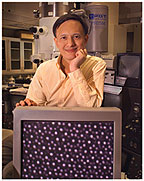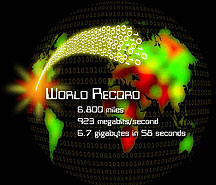Research
Highlights...
|
 |
| Number 127 |
March 3, 2003 |
|
Leave for Mars without fuel to return?
Engineers at DOE's Pacific Northwest
National Laboratory are making traveling to Mars more feasible
and less costly thanks to microchannel process technology. Engineers
are developing a lightweight, micro chemical processing plant
about the size of a desktop personal computer. The processor would
convert carbon dioxide from the Martian atmosphere into the propellant
and oxygen needed for the return trip. Considering the cost of
putting items into orbit can be as much as $20,000 per pound,
packing fuel from earth for a return trip is incredibly expensive.
The ability to produce fuel while on Mars would be much more efficient,
economical and practical. Closer to home, this same miniature
technology also can be used to regenerate life-giving oxygen from
exhaled breath, for example, to soldiers in closed-atmosphere
systems such as vehicles and air-tight suits used during a chemical
or biological attack.
[Geoff Harvey, 509/372-6083,
geoffrey.harvey@pnl.gov]
|
|
Cancer treatment packs
punch to tumor
 |
| Processing californium-252 |
Doctors will soon have a new
treatment for incurable brain tumors and other therapy-resistant
cancers. Developed by Isotron, of Alpharetta, Ga., and DOE's Oak
Ridge National Laboratory, the new treatment enables physicians
to deliver a highly concentrated dose of californium-252 neutrons
to the site of a tumor instead of having to treat the tumor with
conventional gamma rays. This therapy has proved particularly
useful against cancers that are resistant to photon and gamma
treatments, which do not kill cancer cells as effectively as do
the californium-252 neutrons. Cancers most resistant to the conventional
treatments include brain tumors, melanoma, sarcoma, certain types
of prostate cancer, locally advanced breast cancer, cervical cancer
and cancer of the head, neck and mouth.
[Ron
Walli, 865/576-0226,
wallira@ornl.gov]
|
|
New control schemes
tested on CART
By capturing more energy and reducing overall wear and tear, researchers
at the National Renewable Energy
Laboratory's National Wind Technology Center hope to eventually
lower the cost of modern wind turbines. Because wind turbines are
designed to capture the highest amount of energy from the wind,
engineers must devise new ways of keeping the turbines from wearing
out quickly. This requires advanced control systems. Tests on the
Control Advanced Research Turbine began last year after two years
of substantial modifications to the control system. Engineers think
these modifications will lead to better performance and reduce the
cost of wind energy.
[Sarah
Holmes Barba, 303/275-3023,
sarah_barba@nrel.gov]
|
|
In situ spectrum of
synthetic methane hydrate
The Methane
Hydrate Research Team at DOE's National
Energy Technology Laboratory is investigating the physical properties
of methane
hydrates, including their use as a storage medium for natural
gas. The team has developed a method of obtaining Raman spectra
of bulk, laboratory-prepared hydrate samples under the conditions
of their synthesis. This unusual capability allows collection of
vibrational spectroscopic data on samples unperturbed by changes
in pressure and temperature, allowing new insights into hydrate
structure, composition, and stability. This technique will be used
to further provide important information about the hydrate, such
as the presence of other cage types and the fraction of cages containing
methane.
[David
Anna, 412/386-4646,
anna@netl.doe.gov]
|
|
New institute offers
"small" potential
When it comes to energy and biochemical systems, smaller really is
better. Researchers at DOE's Pacific
Northwest National Laboratory and Oregon
State University have teamed to advance their discoveries in
the field of microtechnology. A virtual groundbreaking to announce
the Microproducts Breakthrough Institute was held in Portland, Ore.
on January 18. Through the institute, PNNL and OSU researchers will
collaborate to miniaturize a variety of devices like a microreactor
the size of a pencil eraser that can help power a computer for days
rather than hours as with batteries, and a lapel pin-sized biosensor
capable of detecting chemical and biological agents. PNNL research
in the early 1990s demonstrated more efficient heat and mass transfer
rates when chemical reactions took place in tiny channels about
the size of a human hair. A dedicated facility in Corvallis, Ore.
is eventually planed.
[Geoff
Harvey, 509/372-6083,
geoffrey.Harvey@pnl.gov]
|
|
Brookhaven's
Yimei Zhu advances TEM technology
 |
|
Yimei
Zhu
|
The transmission electron microscope (TEM) has so far provided
mostly qualitative images about the microstructure, defects
and arrangement of atoms in a sample. But Yimei Zhu, a senior
scientist in the Materials Science Department at DOE's Brookhaven
National Laboratory, has advanced the TEM to provide new
insights into the electronic and magnetic structure and behavior
of functional materials, such as superconductors and magnetic
materials.
Unlike optical and x-ray microscopes, which use light to magnify
objects, an electron microscope projects high-energy electrons
toward a sample of solid matter. The electrons that penetrate
the sample are transmitted through it to reveal its inner structure.
By looking at how the waves created by the electrons interfere
with each other after they cross the sample, Zhu and his collaborators
developed techniques that provide very rich information not
only on the misalignment of atoms at the level of a billionth
of a meter with an accuracy of a trillionth of a meter, but
also on the detailed distribution of electron clouds and magnetic
spin in materials.
Examples of Zhu's team's recent achievements with Brookhaven's
advanced
TEM include revealing distribution and symmetry of valence
electrons of a newly discovered superconductor, which, below
certain temperatures, conduct electricity with no energy loss;
and magnetization and interaction of tiny patterned magnetic
arrays, which have potential applications for recording media
technology.
Acknowledging Zhu's accomplishments and potential, DOE's Office
of Science expanded his research program and awarded Brookhaven
funding for a new microscope. "I am pleased and honored that
our research has been recognized by DOE," says Zhu. "Looking
at atoms, electrons and spins is so fascinating that I want
to share the excitement with both scientists and nonscientists."
Submitted by DOE's Brookhaven
National Laboratory
|
|



